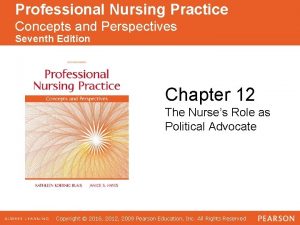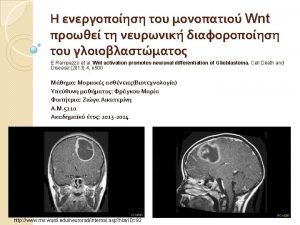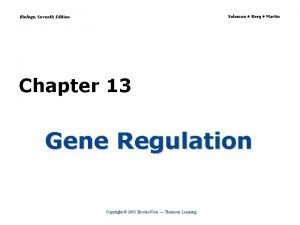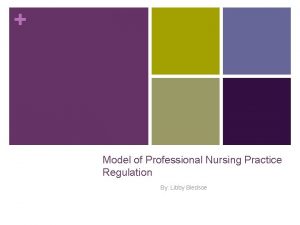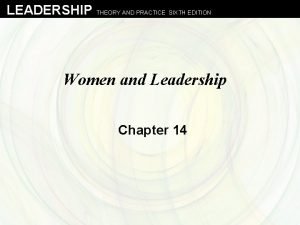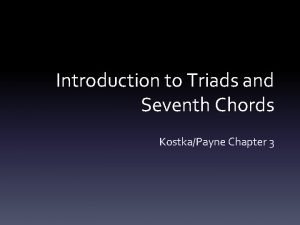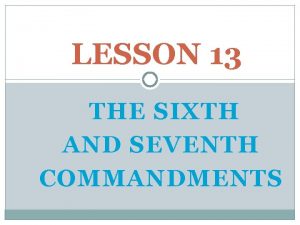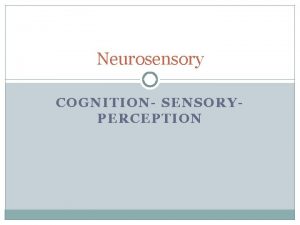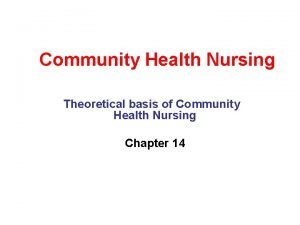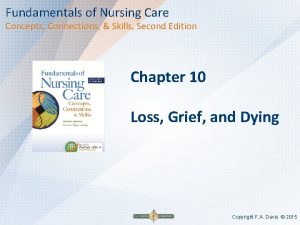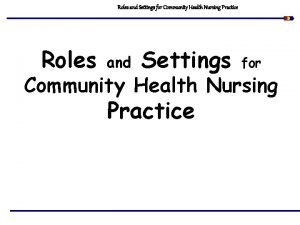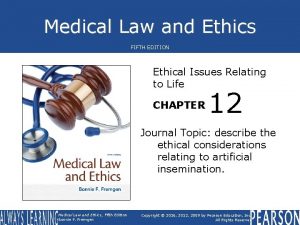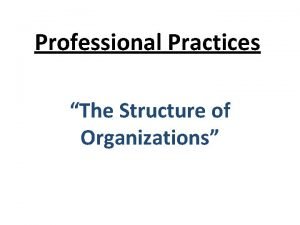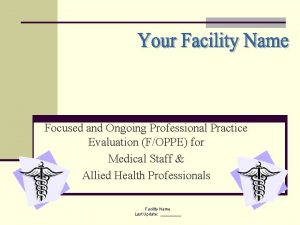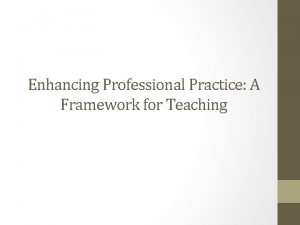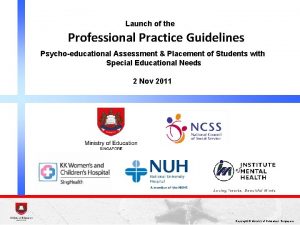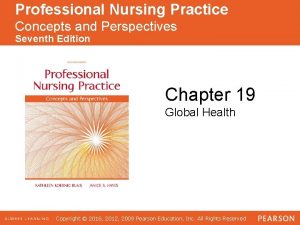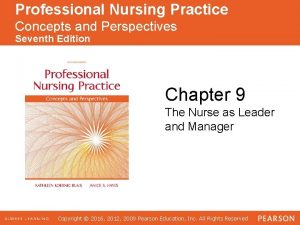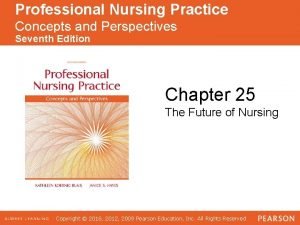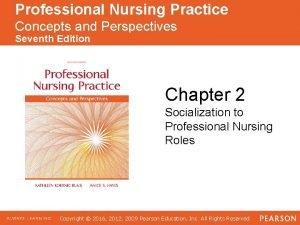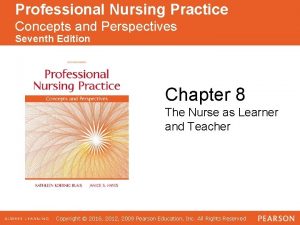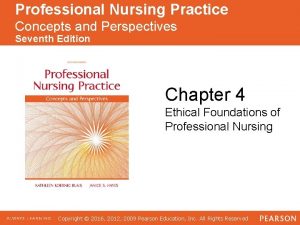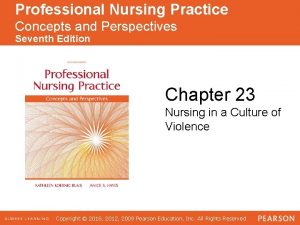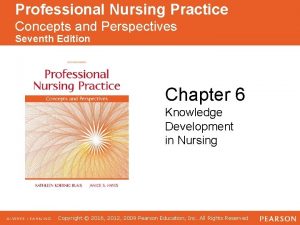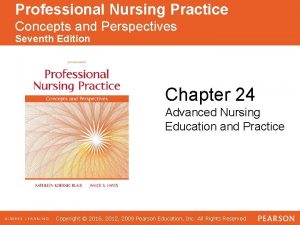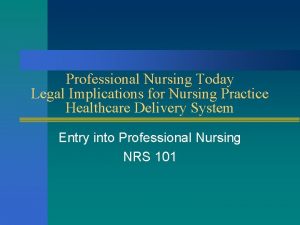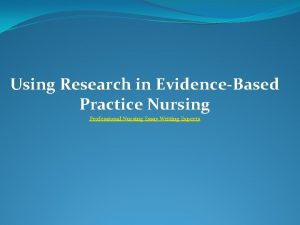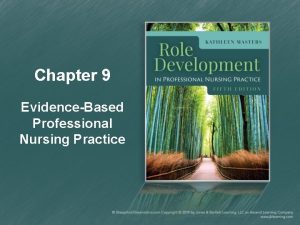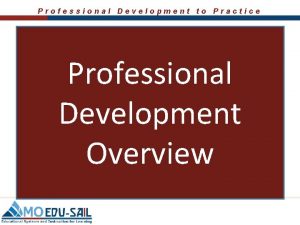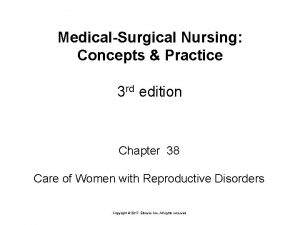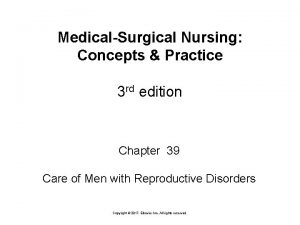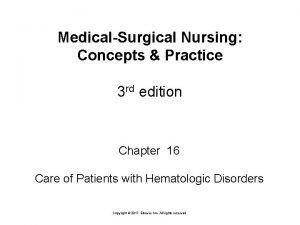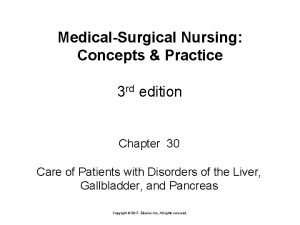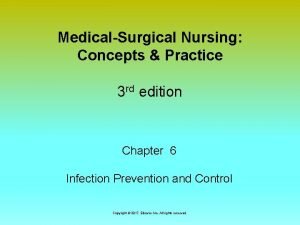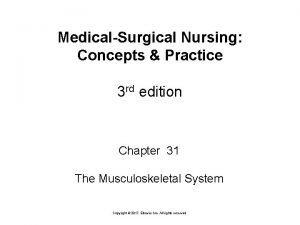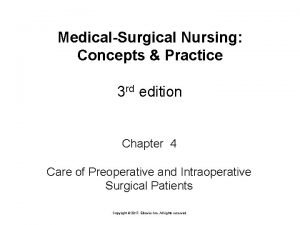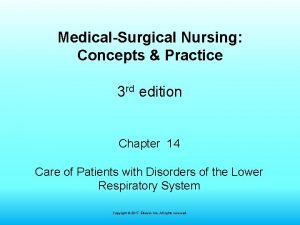Professional Nursing Practice Concepts and Perspectives Seventh Edition





































- Slides: 37

Professional Nursing Practice Concepts and Perspectives Seventh Edition Chapter 7 The Nurse as Health Promoter and Care Provider Copyright © 2016, 2012, 2009 Pearson Education, Inc. All Rights Reserved

Learning Objectives 7. 1 Differentiate between health prevention or protective care and health promotion. 7. 2 Discuss essential components of health promotion. 7. 3 Discuss the overarching goals, foundation health measures, topics, and objectives of Healthy People 2020. 7. 4 Identify various types of and sites for health promotion programs. 7. 5 Compare and contrast the locus-of-control and health belief models as they relate to healthcare decision making. 7. 6 Compare and contrast Pender’s Health Promotion Model (HPM) and the Neuman Systems Model as they relate to health-promotion decision making. 7. 7 Discuss Prochaska and Di. Clemente’s five-stage model of behavior change. 7. 8 Analyze the nurse’s role in health promotion. Copyright © 2016, 2012, 2009 Pearson Education, Inc. All Rights Reserved

Hallmark Features • A focus on foundational knowledge related to professional nursing – Includes nursing history, nursing theory, ethics, and legal aspects, etc. • An overview of professional nursing roles, issues, and changes in the profession – Discusses nurses as healthcare providers, learners and teachers, and leaders Copyright © 2016, 2012, 2009 Pearson Education, Inc. All Rights Reserved

Challenges and Opportunities • Health care and nursing traditionally oriented toward curing and treating – Shift of focus toward maintaining and promoting health and wellness – Role of health promoter provides nurse with many opportunities to ª Educate ª Practice in variety of settings Copyright © 2016, 2012, 2009 Pearson Education, Inc. All Rights Reserved

Learning Objective 7. 1 Differentiate between health prevention or protective care and health promotion. Copyright © 2016, 2012, 2009 Pearson Education, Inc. All Rights Reserved

Defining Health Promotion • Universally accepted definition does not exist; confused with health education • World Health Organization (2015 a) definition – “The process of enabling people to increase control over, and to improve, their health. It moves beyond a focus on individual behavior towards a wide range of social and environmental interventions. ” Copyright © 2016, 2012, 2009 Pearson Education, Inc. All Rights Reserved

Defining Health Promotion • Maville and Huerta (2013) definition of health promotion – “Any endeavor directed at enhancing the quality of health and well-being of individuals, families, groups, communities, and/or nations through strategies involving supportive environments, coordination of resources, and respect for personal choice and values. ” Copyright © 2016, 2012, 2009 Pearson Education, Inc. All Rights Reserved

Learning Objective 7. 2 Discuss essential components of health promotion. Copyright © 2016, 2012, 2009 Pearson Education, Inc. All Rights Reserved

Defining Health Promotion • Leavell and Clark levels of prevention – Primary ª Health promotion ª Protection against specific health problems – Secondary ª Early identification ª Prompt intervention – Tertiary ª Restoration and rehabilitation Copyright © 2016, 2012, 2009 Pearson Education, Inc. All Rights Reserved

Defining Health Promotion • Pender, Murdaugh, and Parsons – Health promotion ª Approach behavior ª Not disease oriented ª Expand positive potential for health – Health protection (primary prevention) ª Avoidance behavior ª Avoiding specific problems ª Thwart occurrence of insult to health and well-being Copyright © 2016, 2012, 2009 Pearson Education, Inc. All Rights Reserved

Learning Objective 7. 3 Discuss the overarching goals, foundation health measures, topics, and objectives of Healthy People 2020. Copyright © 2016, 2012, 2009 Pearson Education, Inc. All Rights Reserved

Healthy People 2020 • Builds on prior Healthy People documents by identifying four goals – Attain high-quality, longer lives – Achieve health equity, eliminate disparities, and improve the health of all groups – Create environments that promote good health for all – Promote quality of life, healthy development, and healthy behaviors across all life stages Copyright © 2016, 2012, 2009 Pearson Education, Inc. All Rights Reserved

Healthy People 2020 • Leading Health Indicators (LHI) reflect highpriority issues, used to – – Assess health of the nation Facilitate collaboration across sectors Motivate action Track progress using specific objectives Copyright © 2016, 2012, 2009 Pearson Education, Inc. All Rights Reserved

Healthy People 2020 • Leading Health Indicators – – – Access to health services Clinical preventive services Environmental quality Injury and violence Maternal, infant, and child health Mental health Copyright © 2016, 2012, 2009 Pearson Education, Inc. All Rights Reserved

Healthy People 2020 • Leading Health Indicators – – – Nutrition, physical activity, and obesity Oral health Reproductive and sexual health Social determinants Substance abuse Tobacco Copyright © 2016, 2012, 2009 Pearson Education, Inc. All Rights Reserved

Healthy People 2020 • Four foundation health measures, indicators of progress – General health status ª Provides information on overall health of a population – Health-related qualify of life and well-being ª Physical, mental, emotional, and social functioning are integrated whole of health status – Determinants of health ª Factors that influence health status – Disparities ª Difference in illness/injury occurrence, health access or health outcomes based on various factors Copyright © 2016, 2012, 2009 Pearson Education, Inc. All Rights Reserved

Learning Objective 7. 4 Identify various types of and sites for health promotion programs. Copyright © 2016, 2012, 2009 Pearson Education, Inc. All Rights Reserved

Health Promotion Activities • Health promotion organizations, wellness centers, traditional healthcare centers offer different approaches • Health programs on an individual level can be passive or active – Passive (client recipient of effort) ª Clean water and air – Active (client committed to involvement) ª Diet management ª Self-help ª Exercise Copyright © 2016, 2012, 2009 Pearson Education, Inc. All Rights Reserved

Health Promotion Activities • Types of programs – Information dissemination ª Billboards, posters, Internet – Health risk appraisal/wellness assessment – Lifestyle and behavior change ª Stress management, nutrition awareness, weight control, smoking cessation, and exercise – Environmental control ª Safe air, food, and water Copyright © 2016, 2012, 2009 Pearson Education, Inc. All Rights Reserved

Health Promotion Activities • Sites for health promotion activities – – – – Home Schools Hospitals Work sites Religious organizations Gyms and fitness centers Shopping malls Internet sites Copyright © 2016, 2012, 2009 Pearson Education, Inc. All Rights Reserved

Learning Objective 7. 5 Compare and contrast the locus-of-control and health belief models as they relate to healthcare decision making. Copyright © 2016, 2012, 2009 Pearson Education, Inc. All Rights Reserved

Health Locus-of-Control Model • Internal locus of control – People who believe they have major influence on own health status; more likely to take initiative, to be more knowledgeable, and to adhere to prescribed regimens • External locus of control – People who believe their health is largely controlled by outside forces; may need assistance to become more internally controlled in order to change behavior Copyright © 2016, 2012, 2009 Pearson Education, Inc. All Rights Reserved

Health Belief Model • Health belief model (HBM) provides framework for understanding why people do not adopt disease prevention strategies – – – Individual perceptions Modifying factors Cues to action Likelihood of action Self-efficacy Copyright © 2016, 2012, 2009 Pearson Education, Inc. All Rights Reserved

Learning Objective 7. 6 Compare and contrast Pender’s Health Promotion Model (HPM) and the Neuman Systems Model as they relate to healthpromotion decision making. Copyright © 2016, 2012, 2009 Pearson Education, Inc. All Rights Reserved

Pender’s Health Promotion Model • Focuses on health-promoting behaviors rather than health-protecting or preventive behaviors • Assumptions emphasize the active role of the client in shaping and maintaining health behaviors and in modifying the environmental context for health behaviors Copyright © 2016, 2012, 2009 Pearson Education, Inc. All Rights Reserved

Pender’s Health Promotion Model • Five components – – – Individual characteristics and experiences Behavior-specific cognitions and affect Commitment to a plan of action Immediate competing demands and preferences Health-promoting behavioral outcomes Copyright © 2016, 2012, 2009 Pearson Education, Inc. All Rights Reserved

Pender’s Health Promotion Model • Individual characteristics and experiences – Prior related behavior ª Previous experience, knowledge, and skill in health-promoting actions – Personal factors ª Biological, psychological, and sociocultural factors Copyright © 2016, 2012, 2009 Pearson Education, Inc. All Rights Reserved

Pender’s Health Promotion Model • Behavior-specific cognitions and affect – – – Perceived benefits of action Perceived barriers to action Perceived self-efficacy Activity-related affect Interpersonal influences Situational influences Copyright © 2016, 2012, 2009 Pearson Education, Inc. All Rights Reserved

Pender’s Health Promotion Model • Commitment to a plan of action – Commitment to carry out a specific health promotion activity at a given time and place and with specific persons or alone – Identification of specific strategies for determining, initiating, and continuing the health promotion behavior Copyright © 2016, 2012, 2009 Pearson Education, Inc. All Rights Reserved

Pender’s Health Promotion Model • Immediate competing demands – Factors over which the individual has a low level of control ª Family and work responsibilities • Immediate competing preferences – Factors over which the individual has a high level of control ª Taste • Behavioral outcome – Adoption and integration of health-promoting behaviors into the individual’s lifestyle Copyright © 2016, 2012, 2009 Pearson Education, Inc. All Rights Reserved

Neuman Systems Model • Wellness oriented, views health promotion as intervention component of prevention • Designed to strengthen a person’s lines of defense • Stages of prevention – Primary – Secondary – Tertiary Copyright © 2016, 2012, 2009 Pearson Education, Inc. All Rights Reserved

Learning Objective 7. 7 Discuss Prochaska and Di. Clemente’s five-stage model of behavior change. Copyright © 2016, 2012, 2009 Pearson Education, Inc. All Rights Reserved

Stages of Health Behavior Change • Cyclical phenomenon in which people progress through several stages – Precontemplation ª Negative aspects of the change outweigh the benefits – Contemplation ª Seriously considers changing a specific behavior – Preparation or planning ª Advantages of changing the behavior outweigh the disadvantages and person makes specific plans to accomplish the change Copyright © 2016, 2012, 2009 Pearson Education, Inc. All Rights Reserved

Stages of Health Behavior Change • Stages – Action ª Actively implements the behavioral and cognitive strategies to interrupt previous behavior patterns and adopt new ones – Maintenance ª Integrates newly adopted behavior patterns into his or her lifestyle – Termination ª Person has no desire to return to previous unhealthy behavior and believes he or she will not relapse Copyright © 2016, 2012, 2009 Pearson Education, Inc. All Rights Reserved

Learning Objective 7. 8 Analyze the nurse’s role in health promotion. Copyright © 2016, 2012, 2009 Pearson Education, Inc. All Rights Reserved

The Nurse’s Role in Health Promotion • Work with people, not for them; act as a facilitator of the process • Maville and Huerta identified roles of the nurse as – – – Activist/proactive change agent Advocate Educator Empowering agent Communicator Copyright © 2016, 2012, 2009 Pearson Education, Inc. All Rights Reserved

The Nurse’s Role in Health Promotion • Roles of the nurse as – – – – Consultant Coordinator of care Member and leader of the health profession Provider of care Research user Researcher into health promotion models Role model Copyright © 2016, 2012, 2009 Pearson Education, Inc. All Rights Reserved
 Professional nursing practice: concepts and perspectives
Professional nursing practice: concepts and perspectives Professional nursing practice concepts and perspectives
Professional nursing practice concepts and perspectives Chords rule in dbms
Chords rule in dbms Endomysium
Endomysium Information management principles
Information management principles Molecular biology of the cell seventh edition
Molecular biology of the cell seventh edition Biology seventh edition
Biology seventh edition Model of professional nursing practice regulation
Model of professional nursing practice regulation Human genetics concepts and applications 10th edition
Human genetics concepts and applications 10th edition Kariogram človeka
Kariogram človeka Operating system concepts, 10th edition
Operating system concepts, 10th edition Operating system concepts 6th edition
Operating system concepts 6th edition Using mis (10th edition) 10th edition
Using mis (10th edition) 10th edition Using mis 10th edition
Using mis 10th edition Cost-benefit analysis concepts and practice
Cost-benefit analysis concepts and practice Leadership theory and practice 6th edition
Leadership theory and practice 6th edition Computer security principles and practice
Computer security principles and practice Computer security principles and practice 4th edition
Computer security principles and practice 4th edition Professional practice finance
Professional practice finance Major 2
Major 2 The fifth, sixth, seventh, and eighth amendments protect *
The fifth, sixth, seventh, and eighth amendments protect * 7th commandment worksheet
7th commandment worksheet Interrelated concepts nursing
Interrelated concepts nursing Salmon white's construct for public health
Salmon white's construct for public health Fundamentals of nursing care concepts connections & skills
Fundamentals of nursing care concepts connections & skills Role of chn nurse
Role of chn nurse Modern real estate practice in pennsylvania 14th edition
Modern real estate practice in pennsylvania 14th edition Ethical problems in the practice of law 5th edition
Ethical problems in the practice of law 5th edition The practice of statistics third edition
The practice of statistics third edition Professional practice days
Professional practice days Structure of organization in professional practice
Structure of organization in professional practice What do you mean by professional
What do you mean by professional Ongoing professional practice evaluation template
Ongoing professional practice evaluation template Enhancing professional practice
Enhancing professional practice Enhancing professional practice
Enhancing professional practice Tpess training
Tpess training Enhancing professional practice a framework for teaching
Enhancing professional practice a framework for teaching Professional practice guidelines moe
Professional practice guidelines moe

